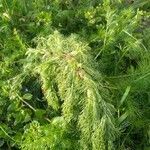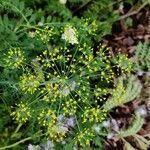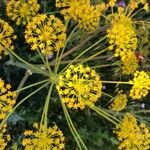A fine leafy herb up to about 1 m tall. It can spread 50 cm across. It is an annual plant regrowing each year from seeds. The root is long and wiry. The stems of the plant are smooth, dark green and with pale stripes. They are finely grooved and hollow. The leaves are bluish-green and like a feather. They can be 35 cm long. The leaves are twice divided and have a sheath wrapping around the stem at the base. The small leaflets are like threads. Flowers are yellow and in flat compound arrangements where flowers are on stalks coming from one point. These flower arrangements can be 9 cm across. The fruit are oval one seeded dry ribbed fruits. Plants have an aniseed scent. The fruit are 1.5 times as long as wide. There are several named cultivars.
Annual. Stems 50-100 cm, terete, striate; sheaths 1½-2 cm in the lower leaves, shorter upwards, white-margined, apex with cucullate-connate auricles; lamina 3-pinnate, segments filiform. Compound umbels terminal to the stems and its branches: peduncles 4-13 cm; rays 5-15, 2-4 cm; pedicels 5-25, ½-1 cm; involucres and involucels none. Calyx teeth none. Petals yellow, strongly curved inward. Mericarps nearly 5 by 3 mm, moreover with a wing ¼-½ mm, oblong.
Plants 30–75(–100) cm, glabrous, strongly aromatic. Basal leaf blade broadly ovate, 3–4-pinnately dissected; ultimate segments narrow linear, 4–20 × ca. 0.5 mm. Upper leaves smaller and less divided, petioles sheathing throughout. Umbels 5–15 cm across; rays 10–25, 3–5 cm; umbellules 15–25-flowered; pedicels 6–10 mm. Fruit brown, 3–5 × 2–2.5 mm; lateral ribs gray-white, narrowly winged. Fl. May–Aug, fr. Jul–Sep.
Annual herb 4-17 dm. tall; leaves oblong to obovate, the blade 13-35 cm. long, 11-20 cm. broad, pinnately decompound, the ultimate divisions filiform, 4-20 mm. long, the petiole 5-6 cm. long; upper cauline leaves greatly reduced; peduncles 7-16 cm. long; rays 10-45, spreading, 3-10 cm. long, the pedicels 20-50, 6-10 mm. long; fruit ovoid, about 4 mm. long, 2 mm. broad.
To 15 dm, branched above, glabrous and ± glaucous throughout; lvs ovate in outline, the lower long-petioled, the upper less so and smaller; ultimate lf-segments 5–20 mm; umbels to 15 cm wide; rays mostly 30–40, spreading, subequal; fr 3–5 mm, half as wide; 2n=22. Native of s. Europe, escaped from cult. throughout most of the U.S. and elsewhere. July, Aug.
Fruit elliptic, strongly dorsiventrally compressed, with a moderately well-developed marginal wing paler in colour than the body of the fruit. Stylopodium lowconical; styles short, clubbed at the apex, divergent and shed before the fruit matures. Dorsal ribs filiform, carpophore 2-cleft to the base.
Umbels terminal, equalled or exceeded by long peduncled laterals. Rays numerous, up to 4 cm. long; bracts and bracteoles 0. Partial umbels with up to 35 flowers, but those of small plants may have as few as 6.
Robust, rather glabrous annual herb up to 75 cm., with a strong characteristic odour.
Vittae well developed, 1 per interval and 2 in the commissural face.
Leaves 3–4-pinnate, ultimate segments narrowly linear to filiform.
Sepals obsolete; petals yellow with an obvious inturned apex.
Stem terete, with numerous fine grooves.










